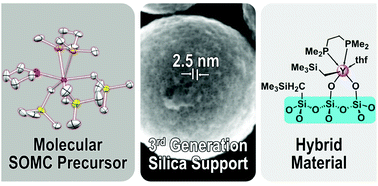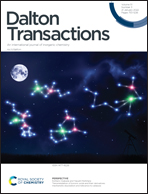Yttrium tris(trimethylsilylmethyl) complexes grafted onto MCM-48 mesoporous silica nanoparticles†
Abstract
A series of tris(trimethylsilylmethyl) yttrium donor adduct complexes was synthesized and fully characterized by X-ray diffraction, 1H/13C/29Si/31P/89Y heteronuclear NMR and FTIR spectroscopies as well as elemental analyses. Treatment of Y(CH2SiMe3)3(thf)x with various donors Do led to complete (Do = TMEDA, DMAP) and partial displacement of THF (Do = NHCiPr, DMPE). Exceptionally large 89Y NMR shifts to low field were observed for the new complexes. Complexes Y(CH2SiMe3)3(tmeda) and Y(CH2SiMe3)3(dmpe)(thf) were chosen to perform surface organometallic chemistry, due to a comparatively higher thermal stability and the availability of the 31P nucleus as a spectroscopic probe, respectively. Mesoporous nanoparticles of the MCM-48-type were synthesized and used as a 3rd generation silica support. The parent and hybrid materials were characterized using X-ray powder diffraction, solid-state-NMR spectroscopy, DRIFTS, elemental analyses, N2-physisorption, and scanning electron microscopy (SEM). The presence of surface-bound yttrium alkyl moieties was further proven by the reaction with carbon dioxide. Quantification of the surface silanol population by means of HN(SiHMe2)2-promoted surface silylation is shown to be superior to titration with lithium alkyl LiCH2SiMe3.



 Please wait while we load your content...
Please wait while we load your content...